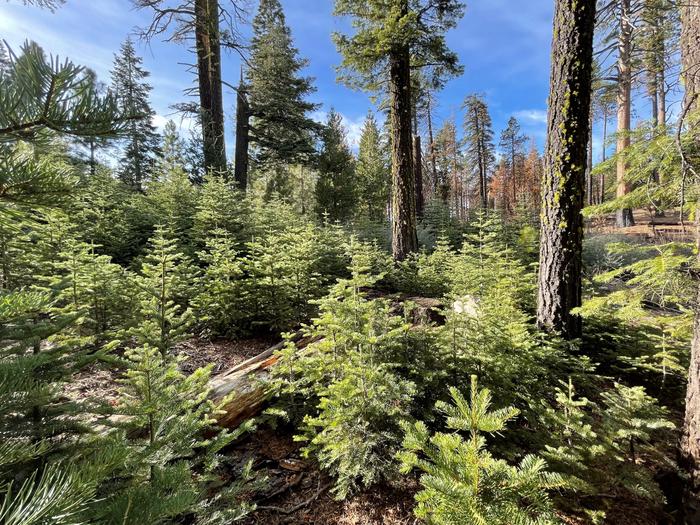Mendocino National Forest Christmas Tree Permit
Keep the family tradition alive this year-or start a new tradition-by cutting a Christmas tree within the Mendocino National Forest. This permit allows you to cut a Christmas Tree within designated areas of the National Forest.
Christmas Tree Permits are being offered to the public in an effort to help reduce excessive fuels that have built up over years of fire suppression. Removal of excessive amounts of small trees from the forest will help create a healthier forest over time.
A permit must be purchased, limited to one permit per household. You can cut up to 3 trees per permit. The number of permits is limited and will be on a first-come, first-served basis. The cost for 2024 is $10 per tree.
Fourth graders with a valid 'Every Kid in a Park' Voucher or Pass are entitled to one free Christmas Tree Tag.
For more information, please visit the Mendocino National Forest Christmas Tree page.
Need to Know
Selecting Your Tree
Each forest has limitations on the size of the tree you can cut and the species of trees that are permitted. See below to help you measure and choose a tree that meets your permit's guidelines.
Tree Height: 10 feet maximum
Stump height: 3 inches maximum
Stump diameter: 5 inches maximum
Cut your tree as close to the ground as possible. Please leave stumps no taller than three (3) inches (the shorter, the better).
Do not cut a tree that will leave an opening of fifteen (15) feet or more between trees.
Do not cut isolated trees growing in the open.
Select Pine, fir, or cedar. Do not cut any hardwood such as aspen or oak.
Take the whole tree of correct size for your home.
Do not cut a larger tree and remove the top of the tree.
If snow is on the ground, remove it from around the stump so you can accurately measure the stump and tree height.
Mendocino and Lake Counties are part of the Sudden Oak Death Quarantine Area. Trees cut within this area may NOT be transported to counties outside of the area.
Where to Cut Your Tree
Permits are non-transferable. No refunds. Permit must be in possession when cutting and transporting tree(s).
Permit holders are not to trespass onto private property when cutting their tree. It is the
permittee's responsibility to determine ownership of land BEFORE cutting begins.
Motorized vehicles are only allowed on existing roads and trails that are open to the public. No off-road travel is allowed (unless by snowmobile in open-riding areas). Refer to the Christmas Tree Cutting Map provided on this webpage.
Download the Christmas Tree Cutting Map to your smartphone or tablet and save it for offline use.
Observe seasonal road closures and be prepared to hike to the cutting area to find a tree.
Permit holders are reminded to park safely off the roadway and do not block gates.
No cutting in areas closed to Christmas tree cutting (refer to map) or where "Christmas Tree Cutting Prohibited" or similar signs are posted.
No cutting within fifty (50) feet of all roads.
You must print and bring your Christmas Tree Permit with you.
Planning Your Trip
Helpful Cutting Tips
Carry your tree carefully out of the woods. Dragging the tree will rub off needles and bark.
Tools to bring with you include a measuring tape; handsaw or axe to cut your tree; gloves to protect your hands; boots to protect your feet; netting or a tarp to sit on and/or to move your tree once it's cut; and rope or straps to secure your tree to your vehicle.
Choose a tree from a dense forested area, which will give the remaining trees more space to grow.
Cut the leftover branches from the stump and scatter them.
If storing your tree outside for a few days before putting it in the house, keep it in an area protected from the wind, such as the north or east side of your house or under a shaded tree.
How to Plan Your Trip
Before you leave home, be sure to measure the space where you plan to place the tree in your home (height and width), and measure the space in your vehicle where you will be transporting the tree.
Cell service may be spotty or unavailable. Be sure someone knows where you are and when to expect you back. Bring plenty of food and water with you as well as an overnight survival kit in case you become stranded. Start your day early. Be sure to find your tree and leave the woods before dark. Dress warmly and take extra dry clothes. Expect winter weather, including cold temperatures, snow and winds.
Check the latest weather conditions, forest warnings and road closures before you leave on your trip. Be aware of changing weather conditions.
Bring a map with you. Don't rely on GPS because it may not be up-to-date with forest service roads.
Roads may not be plowed. Carry tire chains, shovel(s) and a tow chain. Bring a spare key and give it to someone else in your party. Don't get locked out of your car! Park in areas so that traffic can get by safely, and do not block gates. Be sure your vehicle has a full tank of gas.
We don't recommend bringing your pets but, if you do, they must be on a leash.
The roads are dirt roads. Do not drive off the roads. This can cause resource damage and your vehicle may be damaged or get stuck. Please drive slowly and watch for road hazards.
